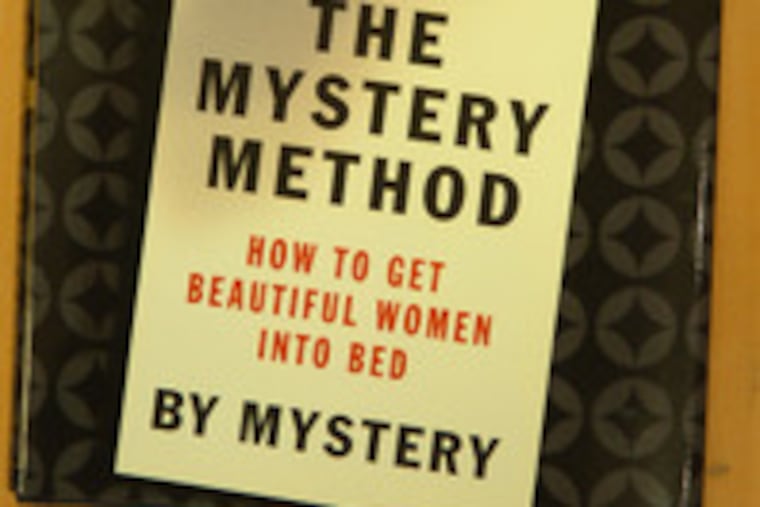Carnal Knowledge | Play hard to get, single guys
That's the advice of pickup artists, and experiments in academia appear to bear it out.

When I was invited a couple of weeks ago to witness a "boot camp" for prospective pickup artists, I jumped at the chance. Men were paying $2,150 apiece for the three-day seminar in the techniques popularized in Neil Strauss' 2005 best seller,
The Game
. The fee included several nights of in-the-field training in New York's nightclub scene.
It sounded potentially sleazy and sexist, but what I really wondered was, could it be useful?
The answer, I found, was, yes, the approach has applications far beyond the realm of frustrated single men.
In a small dance studio in New York, four students and an instructor sat in a circle and shared intimate details of their lives.
I'd been invited by a publicist for Erik von Markovic, a.k.a. Mystery - pickup artist, magician, main character in The Game, and now author of his own pickup manual, The Mystery Method - How to Get Beautiful Women Into Bed.
Most of the classes are taught by Mystery's disciples - in this case a U.S. Marine and part-time comic who goes by the moniker Future. He is 26 and, with leftover baby fat around the chin and a Superman T-shirt, he looks like a big kid.
Before he became Future, he had trouble meeting women.
"I had this image that New York would be rife with women clamoring to get some veteran ass," he said, but somehow, they weren't.
Prior to boot camp in 2004, he'd walk up to a woman and say, "You're the most beautiful woman here." He once even followed one onto a dance floor to say it again before she snapped, "I heard you the first time," as she danced away.
Now Future says he understands why that approach was unlikely to get him a second look, let alone sex.
He explained to his students that the method has nine parts - three stages of attraction (A1, A2 and A3), three of comfort-building (C) and three for sex (S). It was clear that for the most part, the students kept getting stuck in the A's.
The focus for the three stages of A was to telegraph what's called "value" in pickup parlance. You can't appear needy or desperate. You can't make them worry about how they're going to get rid of you.
So to start with, you introduce a "false time constraint," Future told his class, all of them busily scribbling notes. When you approach a group of strangers in a bar or club, you say you can only stay a moment because you have to get back to your friends, or catch a train or something. It makes you seem in control, and in demand.
Future later demonstrated some effective uses of body language. Never plant yourself in front of a woman you're picking up, he said. You've got to come in at an oblique angle, look over your shoulder and appear to be moving away. Then there's the "neg," which is a mildly negative statement, like big brotherly teasing, designed to show you're not trying to pick up the person you're in fact trying to pick up.
It all seemed like good advice to me. There's nothing wrong with a little challenge.
Though I couldn't find any psychologists who'd studied the details of "The Method," I did find some who had experimented with the broader principles involved. Paul Eastwick of Northwestern University wanted to know whether those who played hard-to-get and appeared very selective did better than those who came off as easy.
To find out, he and other psychologists set up their own speed-dating events for undergraduates. A group of men and women rotated through a series of four-minute chats. Afterward, they wrote down who they wanted to see again.
Eastwick asked them to rate their desire to date each of their prospective matches on a scale from one to nine. They were also asked to guess how many people their opposite-sex counterparts would choose.
The results: The students of both sexes were surprisingly good at surmising who said yes to nearly everyone and who didn't. And there was a definite correlation between how picky you were, how picky people thought you were, and how many people wanted you.
Of course, being attractive can make you picky, but Eastwick said his team corrected for attractiveness.
In an essay called "The Pleasure (and Pain) of Maybe," Stanford neuroscientist Robert Sapolsky suggests that playing hard to get may activate your target's dopamine circuits - the same ones associated with cocaine use and other addictive habits.
Researchers tracking the dopamine pathways in the brains of monkeys found peaks of activity after the animals pressed a lever but before they were rewarded with a treat, Sapolsky said. The dopamine surged even more, however, when they changed the rules so the animals got a reward only half the time.
This story got even more interesting when I met Mystery himself. Maybe I'll write about that in my next column. I'd give it about 50-50 odds.
Carnal Knowledge | Health & Science
Columns
Blogs
Keep up with The Inquirer's Health & Science coverage all week at http://go.philly.com/health&scienceEndText